Discover Florida Nature
It's time to explore the natural Florida


|
|
|
|
|
Like the name implies, aquatic grasses are grassy plants than grow in
water. Some grow completely submerges in water, while other have their
roots under water and the top of the plant came be seen above the water
line.
There are many native aquatic grasses, sedges and rushes in Florida.
Among Florida's native giant grasses are sugarcane plume grass and giant
foxtail. Shorter grasses, such as maidencane and knot-grass, grow in
shallow marshes and lake margins and are extremely valuable to Florida's
fisheries. Among the sedges are sawgrass (though this, the dominant
plant in the Everglades, resembles a grass and is called "sawgrass",
it's not a grass), and star-rush. Then there are the bulrushes and the
true rushes of Florida, such as soft rush. 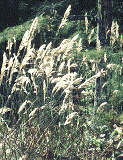 Sugarcane
Plume Grass (Saccharum giganteum)- Saccharum giganteum is commonly
found growing in flatwoods,
marshes, coastal
swales, cypress ponds and lake shores throughout Florida. This large
grass is a native, believed to have been a dominant grassland plant in
the Southeast U.S. before humans arrived. It may be confused with
several other wetland grasses, including several other plume grasses in
Florida. Unlike the others, when mature, sugarcane plume grass has a
large and conspicuous wooly plume-like inflorescence. Different stages
of inflorescence growth look different from one another. Sugarcane plume
grass stem's are reed like, growing up to 12 feet tall forming basal
clumps. The leaf blades are long, and flat, up to 3/4 in. wide, and
having a collar with fringe hairs. On large plants the plume is pink
becoming whitish, and dense, growing to 18 inches long and 5 inches
wide. Sugarcane
Plume Grass (Saccharum giganteum)- Saccharum giganteum is commonly
found growing in flatwoods,
marshes, coastal
swales, cypress ponds and lake shores throughout Florida. This large
grass is a native, believed to have been a dominant grassland plant in
the Southeast U.S. before humans arrived. It may be confused with
several other wetland grasses, including several other plume grasses in
Florida. Unlike the others, when mature, sugarcane plume grass has a
large and conspicuous wooly plume-like inflorescence. Different stages
of inflorescence growth look different from one another. Sugarcane plume
grass stem's are reed like, growing up to 12 feet tall forming basal
clumps. The leaf blades are long, and flat, up to 3/4 in. wide, and
having a collar with fringe hairs. On large plants the plume is pink
becoming whitish, and dense, growing to 18 inches long and 5 inches
wide. 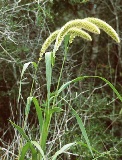 Giant
foxtail
(Setaria magna)- Giant Foxtail is frequently found growing in
swamps and wet disturbed sites from
the peninsula west to the central panhandle of Florida. Giant Foxtail
blooms year round and occurs almost always under natural conditions in
wetlands. The native giant foxtail is much larger than its cousin,
knotroot foxtail. It might first be noticed as a large spike or
"foxtail" on top of a very large grass, growing in a deep ditch. Giant
foxtail produces large seeds which are valuable wildlife food. Giant
foxtail
(Setaria magna)- Giant Foxtail is frequently found growing in
swamps and wet disturbed sites from
the peninsula west to the central panhandle of Florida. Giant Foxtail
blooms year round and occurs almost always under natural conditions in
wetlands. The native giant foxtail is much larger than its cousin,
knotroot foxtail. It might first be noticed as a large spike or
"foxtail" on top of a very large grass, growing in a deep ditch. Giant
foxtail produces large seeds which are valuable wildlife food.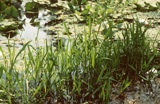 Maidencane
(Panicum hemitomon)- The valuable and common native maidencane can form
large stands in the water or even on dry banks. It may be confused with
torpedo grass, para grass, cupscale grass or blue maidencane. Maidencane
provides food, protection and nesting materials for wildlife. Maidencane
is a grass with stems growing to 6 feet long, and has narrow, erect
leaf blades that are flat or folded, wide with sizes up to 1 inch wide
and 12 inches. long, Maidencane has stalked, green flowers that grow to
1/8 inch long, and are pressed against it's branches. Maidencane
(Panicum hemitomon)- The valuable and common native maidencane can form
large stands in the water or even on dry banks. It may be confused with
torpedo grass, para grass, cupscale grass or blue maidencane. Maidencane
provides food, protection and nesting materials for wildlife. Maidencane
is a grass with stems growing to 6 feet long, and has narrow, erect
leaf blades that are flat or folded, wide with sizes up to 1 inch wide
and 12 inches. long, Maidencane has stalked, green flowers that grow to
1/8 inch long, and are pressed against it's branches. 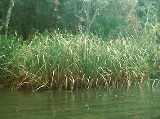 Sawgrass (Cladium
jamaicense)- The aptly named saw-grass is a large sedge, and is the
dominant plant of the Everglades.
It also occurs throughout the southeastern U.S. growing in fresh- and
brackish-water wetlands where it provides food and shelter to
water birds and other animals. Two species
of Cladium exist in Florida. The sawgrass stems are hollow, and grow
4-10 feet. tall, Sawgrass leaf blades are large, stiff, from the base,
and relatively narrow, growing up to 3/4 inches wide and more than 3
feet long. It's margins and underside midribs have small sharp saw
teeth, giving the sawgrass plant it's name. Sawgrass spikelets are a
light reddish brown nutlet in a tiny wrinkled ovoid. Sawgrass (Cladium
jamaicense)- The aptly named saw-grass is a large sedge, and is the
dominant plant of the Everglades.
It also occurs throughout the southeastern U.S. growing in fresh- and
brackish-water wetlands where it provides food and shelter to
water birds and other animals. Two species
of Cladium exist in Florida. The sawgrass stems are hollow, and grow
4-10 feet. tall, Sawgrass leaf blades are large, stiff, from the base,
and relatively narrow, growing up to 3/4 inches wide and more than 3
feet long. It's margins and underside midribs have small sharp saw
teeth, giving the sawgrass plant it's name. Sawgrass spikelets are a
light reddish brown nutlet in a tiny wrinkled ovoid. 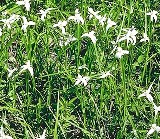 Star-Rush
(Dichromena species)- Star-rush is an immersed plant, and is also known
as "white-top sedge". This conspicuous plant may be found growing in wet
open areas,
flatwoods,
depressions and ditches. This Dichromena species is the only one of its
kind in Florida, a variation of Rhynchospora colorata. Star-rush has
extensive rhizomes and can cover a substantial area. It is the only
sedge-like plant that has 3 to 10 white, pointed "leaves" at the top of
the plant. The "leaves" of the star-rush are actually large bracts that
surround the less-conspicuous inflorescence. The bracts are white at the
base, becoming green at the tips. The inflorescence of star-rush is a
head-like cluster of whitish spikelets. Its real leaves arise from the
base of the plant Star-Rush
(Dichromena species)- Star-rush is an immersed plant, and is also known
as "white-top sedge". This conspicuous plant may be found growing in wet
open areas,
flatwoods,
depressions and ditches. This Dichromena species is the only one of its
kind in Florida, a variation of Rhynchospora colorata. Star-rush has
extensive rhizomes and can cover a substantial area. It is the only
sedge-like plant that has 3 to 10 white, pointed "leaves" at the top of
the plant. The "leaves" of the star-rush are actually large bracts that
surround the less-conspicuous inflorescence. The bracts are white at the
base, becoming green at the tips. The inflorescence of star-rush is a
head-like cluster of whitish spikelets. Its real leaves arise from the
base of the plant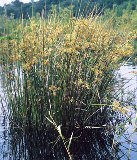 Soft
Rush
(Juncus effusus)- One of the most common species of Juncus, the
native soft rush may be found as a single clump, as a colony of clumps
or as a colony of single stems several feet tall, in water or on "dry"
ground. It may be found in both freshwater and saltwater wet areas. Soft
rush provides food and nesting to birds and other wildlife. Twenty-one
species of Juncus occurs in Florida. Soft rush is a true rush. Its
pale-green stems are erect and two to five feet tall. Stems are
cylindrical and filled with pithy pith. Soft rush has no leaves. Leafy
reddish sheaths wrap the stems at the bottom of the plant. The
inflorescence of soft rush appears to be coming out of the side of the
stem. The inflorescence is open and branched. Each branch has 30-100
small flowers, each greenish-brown flower on its own stalk. Above the
inflorescence is a "continuation" of the pointed stem, this being a
stiff, rolled and pointed bract, usually brown or grayish when mature. Soft
Rush
(Juncus effusus)- One of the most common species of Juncus, the
native soft rush may be found as a single clump, as a colony of clumps
or as a colony of single stems several feet tall, in water or on "dry"
ground. It may be found in both freshwater and saltwater wet areas. Soft
rush provides food and nesting to birds and other wildlife. Twenty-one
species of Juncus occurs in Florida. Soft rush is a true rush. Its
pale-green stems are erect and two to five feet tall. Stems are
cylindrical and filled with pithy pith. Soft rush has no leaves. Leafy
reddish sheaths wrap the stems at the bottom of the plant. The
inflorescence of soft rush appears to be coming out of the side of the
stem. The inflorescence is open and branched. Each branch has 30-100
small flowers, each greenish-brown flower on its own stalk. Above the
inflorescence is a "continuation" of the pointed stem, this being a
stiff, rolled and pointed bract, usually brown or grayish when mature. |
|
|
Advertise | Privacy Statement | Dog Encyclopedia | Video |Contact | Alaska Nature |
|